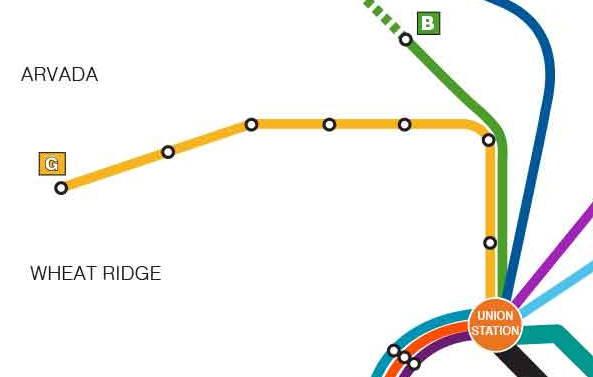Takeaways From a Ride on RTD’s B-Line, Denver’s Newest Rail Route

RTD is having a busy 2016, and it continued Monday with the opening of the B-Line between Westminster and Union Station.
The commuter rail line gets people between downtown and Westminster in 11 minutes. It arrives every 30 minutes during peak hours (5:50 – 8:30 a.m. and 3:20 – 7:30 p.m.) and every hour the rest of the day. The train, which costs $2.60 one-way, does not stop between downtown and its northern suburb.
I hopped on the B-Line at Union Station yesterday afternoon, took the quick trip to Westminster Station, and walked around for a bit. Here are some takeaways.
There are two stations along the B-Line that the train does not serve.
Flying by at 79 mph, the train passed two RTD stations. Those are the Pecos Junction and 41st and Fox stations — part of the G-Line, scheduled to open this fall. You’d think both the B and G Lines would utilize the stops. Doing so would mean trains come more frequently, and higher frequency grows ridership by providing shorter wait times and flexibility for riders.

This setup limits how people can use the line. Say a family lives near Pecos Junction and wants to take the train to Westminster a few miles north. They would have to hop on the G-Line, travel south to Union Station, transfer to the B-Line, and head back north to Westminster Station — passing their origin point on the way. How many people will choose to do that?
Nate Currey, an RTD spokesperson, said the transit agency had to designate the G and B lines as separate corridors to satisfy a billion-dollar-plus grant from the Federal Transit Administration. RTD has “every intention of reviewing our system a year after it opens,” Currey said. We could eventually see both lines serve those stops, he said. (Looking further ahead, however, if the B-Line is ever fully built out to Boulder, those stops will probably get bypassed to save time.)

The train was standing room only in both directions, and it was a fast trip.
Lots of people used the B-Line on opening day, and many carried shopping bags and carts like they were running daily errands, not just taking a ride for the novelty. The trip each way was 11 minutes on the dot. (Google Maps says it’s a 25-minute drive station to station.) Still, RTD estimates the B-Line’s average ridership will be just 800 passengers per weekday this year. Which does make sense, when you consider the land use around Westminster Station…

Cars and parking are king at Westminster Station.
Westminster Station is another example of RTD’s penchant for building drive-to transit. The RTD parking garage has 350 stalls for car storage and RTD plans to add 650 more. A privately run lot has 250 spots for a total of 600. There are 20 bike racks and 18 bike lockers. Two RTD bus lines serve the station — the 72 and the 31 — with service every 30 minutes.
A brand new street, Westminster Station Drive, was constructed to connect Federal Boulevard to the station. But it only has a sidewalk on one side. Sidewalks in the neighborhood closest to the station are just three feet wide. The street does have bike lanes and a Zagster bike-share station, but nearby Federal Boulevard — a speedway under Colorado DOT’s jurisdiction — impedes the bikeability of the neighborhood.

Westminster Station does not anchor a walkable area — at least not yet.
Westminster Station is not surrounded by compact development with a mix of housing, retail, and office space that can be easily accessed on foot. The main feature is a 40-acre park that doesn’t exist yet (currently it’s just a lot of dirt). The park paths will connect a neighborhood of single-family homes to the station, but will also act as a buffer. A few low-rise apartment buildings sit near the station’s north side, but the closest neighbor is actually a sprawling RV dealership. There are only 300 residential units and 130 jobs with the 135 acres surrounding the station, according to the Denver Business Journal.

One development is in the pipeline: A 70-unit affordable housing project with retail and office space on the lower floors at 71st and Federal. The city of Westminster imagines a “vibrant, mixed-use district” around the station, but it will be a while before that vision becomes reality. The city is just now working on a land use plan for the area.


